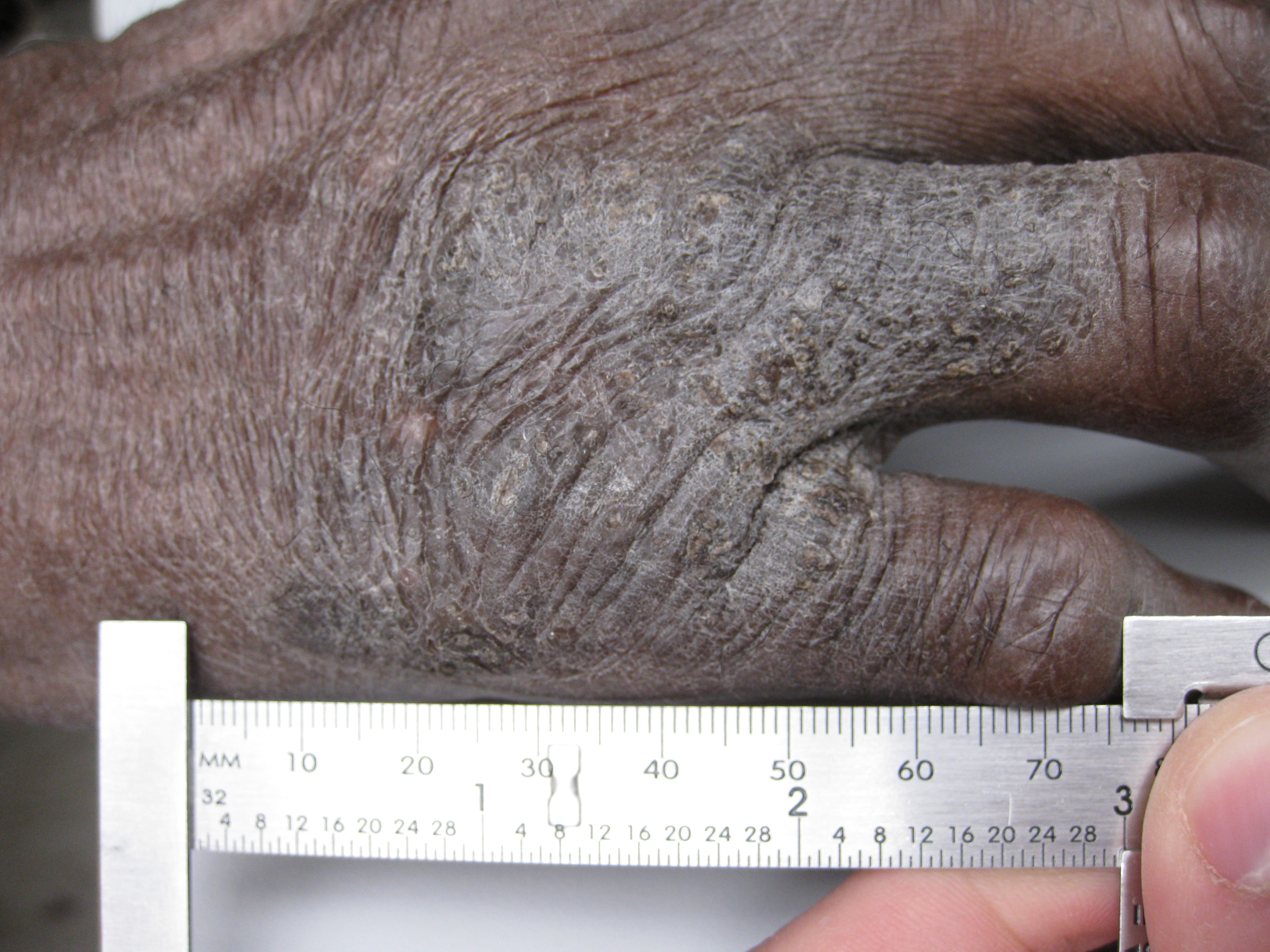
Image: "Lichen simplex chronicus" by kilbad is licensed under CC BY-SA 3.0. Link to the source.
Lichen Simplex Chronicus
Introduction | Aetiology and Risk Factors | Clinical Presentation | Diagnosis | Management and Treatment | Prevention | When to Refer | References
Introduction
Lichen Simplex Chronicus (LSC) is a skin condition characterised by chronic itching and scratching that leads to thickened, leathery, and hyperpigmented plaques. It is often considered a secondary condition arising from chronic rubbing or scratching of the skin due to an underlying primary pruritic disorder. Lichen Simplex Chronicus is also known as neurodermatitis and can significantly affect a patient's quality of life due to the persistent itch-scratch cycle.
Aetiology and Risk Factors
LSC develops as a result of chronic scratching or rubbing, which can be triggered by various underlying conditions or external factors:
- Underlying Dermatological Conditions: Conditions such as atopic dermatitis, psoriasis, or contact dermatitis can lead to chronic itching, triggering LSC.
- Psychological Factors: Stress, anxiety, and other psychological conditions can contribute to the itch-scratch cycle that characterises LSC.
- External Irritants: Exposure to irritants, such as harsh soaps, rough fabrics, or insect bites, can initiate or exacerbate itching and scratching.
- Nerve Disorders: Conditions that cause neuropathic itch, such as post-herpetic neuralgia, can lead to LSC.
Clinical Presentation
Lichen Simplex Chronicus presents with specific features that are typically easy to identify:
- Thickened, Leathery Plaques: The affected skin becomes thickened (lichenified), with an accentuated skin marking (lichenification) and a leathery texture.
- Hyperpigmentation: The skin in the affected area often becomes darker than the surrounding skin due to chronic inflammation and scratching.
- Intense Itching: Patients experience persistent itching, particularly in the evening or at night, which leads to scratching and further thickening of the skin.
- Common Sites: LSC commonly affects areas within easy reach for scratching, such as the nape of the neck, wrists, forearms, ankles, and genitals.
- Chronic Course: The condition is often chronic and can persist for months or years if not adequately managed.
Diagnosis
The diagnosis of Lichen Simplex Chronicus is primarily clinical, based on the characteristic appearance and patient history:
- History: A thorough history should be taken, focusing on the onset of itching, any underlying dermatological conditions, psychological stressors, and exposure to potential irritants.
- Physical Examination: The diagnosis is often made based on the appearance of thickened, hyperpigmented plaques and the presence of lichenification.
- Biopsy: A skin biopsy is rarely needed but may be performed to rule out other conditions, such as psoriasis or lichen planus, if the diagnosis is unclear.
Management and Treatment
The management of Lichen Simplex Chronicus focuses on breaking the itch-scratch cycle, treating the underlying cause, and protecting the skin:
1. Topical Treatments
- Topical Corticosteroids:
- Potent topical corticosteroids (e.g., betamethasone) are the first-line treatment to reduce inflammation and itching. Apply once or twice daily, depending on the severity.
- In areas with thinner skin, such as the face or genitals, a milder corticosteroid (e.g., hydrocortisone) may be used to minimise the risk of side effects.
- Topical Calcineurin Inhibitors:
- For sensitive areas or long-term use, topical calcineurin inhibitors (e.g., tacrolimus, pimecrolimus) can be used as an alternative to corticosteroids.
- Emollients:
- Regular use of emollients helps to moisturise the skin, reduce itching, and protect the skin barrier.
- Topical Antihistamines or Anaesthetics:
- These can provide additional relief from itching, particularly in the evening when symptoms may worsen.
2. Oral Treatments
- Oral Antihistamines:
- Sedating antihistamines (e.g., hydroxyzine, diphenhydramine) can help manage nocturnal itching and improve sleep.
- Anxiolytics or Antidepressants:
- In cases where stress or anxiety is contributing to the itch-scratch cycle, anxiolytics or antidepressants may be prescribed.
3. Behavioural Therapy
- Cognitive Behavioural Therapy (CBT): CBT may be beneficial for patients with LSC to help address the psychological factors contributing to the condition and to develop strategies for managing the urge to scratch.
- Habit-Reversal Therapy: This therapy focuses on replacing the scratching behaviour with other, less harmful actions.
4. Protection of the Skin
- Physical Barriers: Use of physical barriers, such as bandages or gloves, can help prevent scratching, particularly at night.
- Avoidance of Triggers: Patients should be advised to avoid known irritants or triggers, such as harsh soaps, rough fabrics, or allergens, that may exacerbate itching.
Prevention
Preventing Lichen Simplex Chronicus involves managing the underlying causes of itching and avoiding factors that can trigger the itch-scratch cycle:
- Treat Underlying Conditions: Effectively managing conditions such as atopic dermatitis, psoriasis, or anxiety can prevent the development of LSC.
- Stress Management: Encouraging patients to manage stress through relaxation techniques, exercise, or counselling can reduce the likelihood of scratching due to psychological factors.
- Skin Care Routine: Regular use of emollients and gentle skin care practices can help maintain skin integrity and prevent itching.
When to Refer
Referral to a specialist may be necessary in the following situations:
- Refractory Cases: If the LSC does not respond to standard treatment, referral to a dermatologist is advised for further evaluation and management.
- Diagnostic Uncertainty: If there is uncertainty about the diagnosis, particularly to rule out other conditions such as psoriasis or lichen planus, referral for a skin biopsy may be necessary.
- Psychological Factors: If psychological factors are significantly contributing to the condition, referral to a psychologist or psychiatrist may be beneficial.
References
- British Association of Dermatologists (2024) Guidelines for the Management of Lichen Simplex Chronicus. Available at: https://www.bad.org.uk (Accessed: 26 August 2024).
- National Institute for Health and Care Excellence (2024) Lichen Simplex: Diagnosis and Treatment. Available at: https://www.nice.org.uk/guidance/ng203 (Accessed: 26 August 2024).
- British National Formulary (2024) Topical and Oral Treatments for Dermatological Conditions. Available at: https://bnf.nice.org.uk/ (Accessed: 26 August 2024).
Check out our YouTube channel
Blueprint Page
Explore the comprehensive blueprint for Physician Associates, covering all essential topics and resources.
Book Your Session
Enhance your skills with personalised tutoring sessions tailored for Physician Associates.

